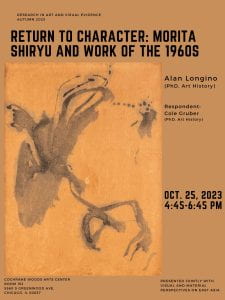This Wednesday, October 25 at 4:45 PM, the RAVE and VMPEA workshops together will be hosting their first collaboration of the year in Room 152 of the Cochrane Woods Art Center (the Home of Art History).
The presenter will be Alan Longino (Ph.D. student, Art History) discussing the work of the calligrapher Morita Shiryu (b. 1912, d. 1998).
Presenting his working paper, Return to Character: Morita Shiryu and Work of the 1960s
The session’s respondent will be Cole Gruber (Ph.D. student, Art History).

For attendees on ZOOM, please register at the link below and use the password given. https://uchicago.zoom.us/meeting/register/tJ0rc-2oqz0oHtSbsPEbL0xMxL4b1ahKArQ4#/registration
Password: 000000
We look forward to seeing many a visage there, and look forward to hosting you for more RAVE & VMPEA collaborations throughout the year.
Abstract
The work and practice of Morita Shiryu—one of the founders of Bokujinkai, editor of the group’s long-running journal, Bokubi, and pioneering philosopher on avant-garde calligraphy—is difficult to pin-down. One of Shiryu’s primary goals was to elevate calligraphy to the level of abstract art being practiced in his time, such as Abstract Expressionism in New York of Art Informel in Paris. This paper looks at a critical point in the history of the artist’s work—the late 1950s to early 1960s—when his style and beliefs around calligraphy slowly turned away from the desire for abstraction and back to the formation of character-based writing. The field of research around his work at this time ties this shift to a growing dissatisfaction with artists in the West, and the limited understanding of Zen philosophies embedded in the work of calligraphy. However, while the stylistic shift in the work is apparent at this time, I argue that due to the philosophies and materials utilized and developed by Shiryu in the 1950s the work became even more progressively avant-garde, and that by developing new compound mixtures with which to paint, he was not only able to tackle even larger format works—such as multi-paneled screens—but that he was able to draw out the temporal qualities of language across these large-scale works. In this effort, he was able to imbue new dimensions into calligraphy, and by doing so achieved an abstraction of characters and language that was even more pronounced than in previous work.
Bio
Alan Longino is a Ph.D. student focusing on postwar Japanese conceptual art and global contemporary art. His research considers the artist Yutaka Matsuzawa (b. 1922 – d. 2006, Shimo Suwa) and the artist’s approach to a dematerialized practice that was hinged upon a system of quantum physics, non-Zen Buddhism, and para-psychology. In 1988, Matsuzawa published his Quantum Art Manifesto, which set out directions, instructions, kōans, and other meditations for the reader to consider their connection to art on a quantum level. This manifesto was the culmination of the artist’s decades-long practice that focused on making the “invisible, invisible” (Tomii, 2016), and is the central focus of his dissertation. In addition to his research on Matsuzawa, he has also produced shows on the artist’s work at Yale Union (Portland, OR, 2019), and Empty Gallery (Hong Kong, 2021) in collaboration with the independent art historian and curator, Reiko Tomii.